小学阶段英语名词单数变复数总结
- 格式:doc
- 大小:45.50 KB
- 文档页数:1
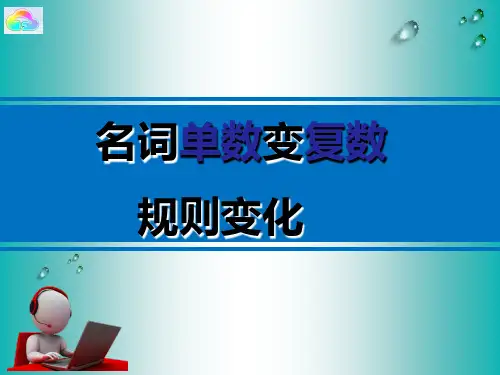
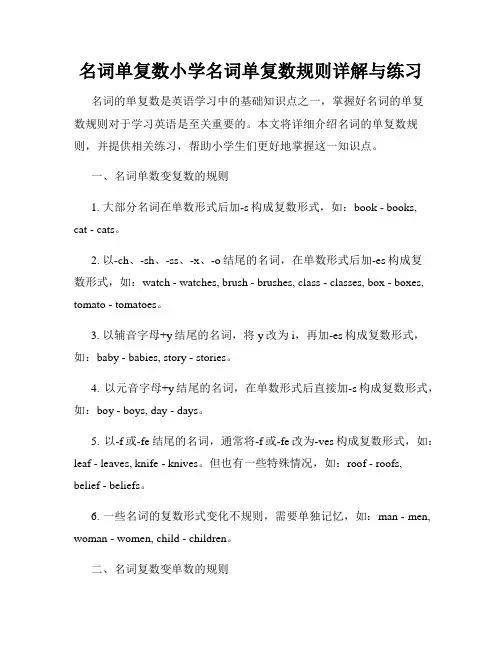
名词单复数小学名词单复数规则详解与练习名词的单复数是英语学习中的基础知识点之一,掌握好名词的单复数规则对于学习英语是至关重要的。
本文将详细介绍名词的单复数规则,并提供相关练习,帮助小学生们更好地掌握这一知识点。
一、名词单数变复数的规则1. 大部分名词在单数形式后加-s构成复数形式,如:book - books, cat - cats。
2. 以-ch、-sh、-ss、-x、-o结尾的名词,在单数形式后加-es构成复数形式,如:watch - watches, brush - brushes, class - classes, box - boxes, tomato - tomatoes。
3. 以辅音字母+y结尾的名词,将y改为i,再加-es构成复数形式,如:baby - babies, story - stories。
4. 以元音字母+y结尾的名词,在单数形式后直接加-s构成复数形式,如:boy - boys, day - days。
5. 以-f或-fe结尾的名词,通常将-f或-fe改为-ves构成复数形式,如:leaf - leaves, knife - knives。
但也有一些特殊情况,如:roof - roofs,belief - beliefs。
6. 一些名词的复数形式变化不规则,需要单独记忆,如:man - men, woman - women, child - children。
二、名词复数变单数的规则1. 大部分名词复数形式去掉s或es即可得到单数形式,如:books - book, cats - cat。
2. 一些名词的单复数形式相同,如:fish - fish, sheep - sheep, deer - deer。
三、名词单复数规则的练习练习一:将下列名词变成复数形式。
1. pen2. house3. apple4. woman5. tomato6. child7. city8. box9. leaf10. thief练习二:将下列名词变成单数形式。
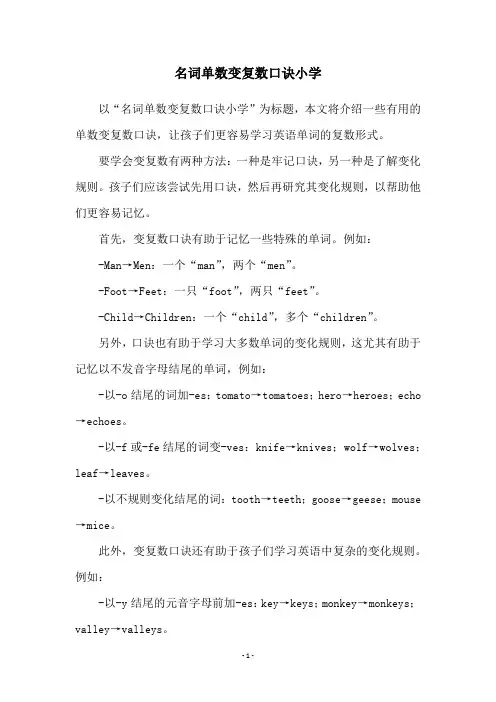
名词单数变复数口诀小学以“名词单数变复数口诀小学”为标题,本文将介绍一些有用的单数变复数口诀,让孩子们更容易学习英语单词的复数形式。
要学会变复数有两种方法:一种是牢记口诀,另一种是了解变化规则。
孩子们应该尝试先用口诀,然后再研究其变化规则,以帮助他们更容易记忆。
首先,变复数口诀有助于记忆一些特殊的单词。
例如:-Man→Men:一个“man”,两个“men”。
-Foot→Feet:一只“foot”,两只“feet”。
-Child→Children:一个“child”,多个“children”。
另外,口诀也有助于学习大多数单词的变化规则,这尤其有助于记忆以不发音字母结尾的单词,例如:-以-o结尾的词加-es:tomato→tomatoes;hero→heroes;echo →echoes。
-以-f或-fe结尾的词变-ves:knife→knives;wolf→wolves;leaf→leaves。
-以不规则变化结尾的词:tooth→teeth;goose→geese;mouse →mice。
此外,变复数口诀还有助于孩子们学习英语中复杂的变化规则。
例如:-以-y结尾的元音字母前加-es:key→keys;monkey→monkeys;valley→valleys。
-以-y结尾的辅音字母变-ies:pony→ponies;sky→skies;factory→factories。
-以-x结尾的单词加-es:box→boxes;tax→taxes;fox→foxes。
另外,一些介词或词根也有助于变复数,例如:-词根“man”:woman→women;Swedish man→Swedish men;postman →postmen。
-介词“in-”:infant→infants;insider→insiders;informer →informers。
总而言之,变复数口诀是小学英语学习中一个重要的话题。
有了口诀,孩子们就可以更轻松地学习英语单词的复数形式,扩大词汇量,进而提高口头表达能力,达到更高的学习水平。
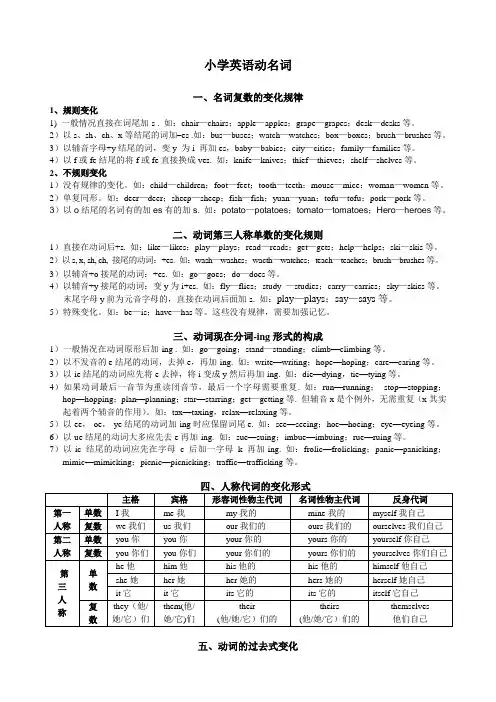
小学英语动名词一、名词复数的变化规律1、规则变化1) 一般情况直接在词尾加-s . 如:chair—chairs;apple—apples;grape—grapes;desk—desks等。
2)以s、sh、ch、x等结尾的词加–es .如:bus—buses;watch—watches;box—boxes;brush—brushes等。
3)以辅音字母+y结尾的词,变y 为i 再加es,baby—babies;city—cities;family—families等。
4)以f或fe结尾的将f或fe直接换成ves. 如:knife—knives;thief—thieves;shelf—shelves等。
2、不规则变化1)没有规律的变化。
如:child—children;foot—feet;tooth—teeth;mouse—mice;woman—women等。
2)单复同形。
如:deer—deer;sheep—sheep;fish—fish;yuan—yuan;tofu—tofu;pork—pork等。
3)以o结尾的名词有的加es有的加s. 如:potato—potatoes;tomato—tomatoes;Hero—heroes等。
二、动词第三人称单数的变化规则1)直接在动词后+s. 如:like—likes;play—plays;read—reads;get—gets;help—helps;ski—skis等。
2)以s, x, sh, ch, 接尾的动词:+es. 如:wash—washes;wacth—watches;teach—teaches;brush—brushes等。
3)以辅音+o接尾的动词:+es. 如:go—goes;do—does等。
4)以辅音+y接尾的动词:变y为i+es. 如:fly—flies;study —studies;carry—carries;sky—skies等。
末尾字母y前为元音字母的,直接在动词后面加-s. 如:play—plays;say—says等。
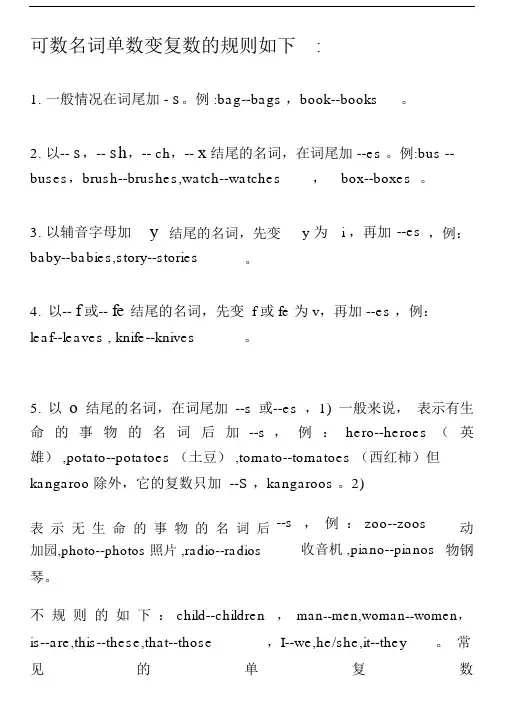
可数名词单数变复数的规则如下:1. 一般情况在词尾加 - s。
例 :bag--bags ,book--books。
2. 以-- s,-- sh,-- ch,-- x结尾的名词,在词尾加 --es 。
例:bus --buses,brush--brushes,watch--watches,box--boxes。
3. 以辅音字母加y结尾的名词,先变y 为i ,再加--es,例:baby--babies,story--stories。
4.以-- f或-- fe结尾的名词,先变 f 或 fe 为 v,再加 --es ,例:leaf--leaves , knife--knives。
5.以o 结尾的名词,在词尾加--s或--es,1)一般来说,表示有生命的事物的名词后加--s ,例:hero--heroes (英雄) ,potato--potatoes (土豆) ,tomato--tomatoes (西红柿)但kangaroo 除外,它的复数只加 --S ,kangaroos 。
2)表示无生命的事物的名词后加园,photo--photos 照片 ,radio--radios --s,例: zoo--zoos收音机 ,piano--pianos动物钢琴。
不规则的如下: child--children,man--men,woman--women,is--are,this--these,that--those,I--we,he/she,it--they。
常见的单复数sheep--sheep,deer--deer,Chinese--Chinese,people--people,fish--fish ,you--you 。
(这是很重要的语法知识,有部分孩子在课堂上没有做笔记,辛苦家长检查下宝贝有没有写好,如没有的,提醒他们抄下来并背熟)这是 U4的重点知识。
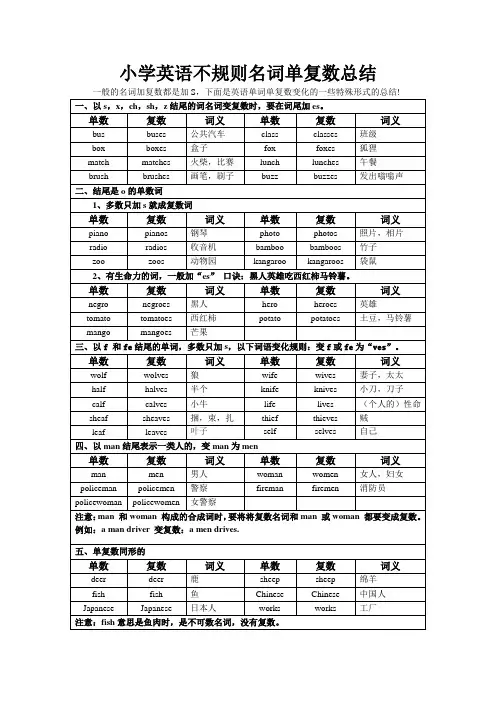
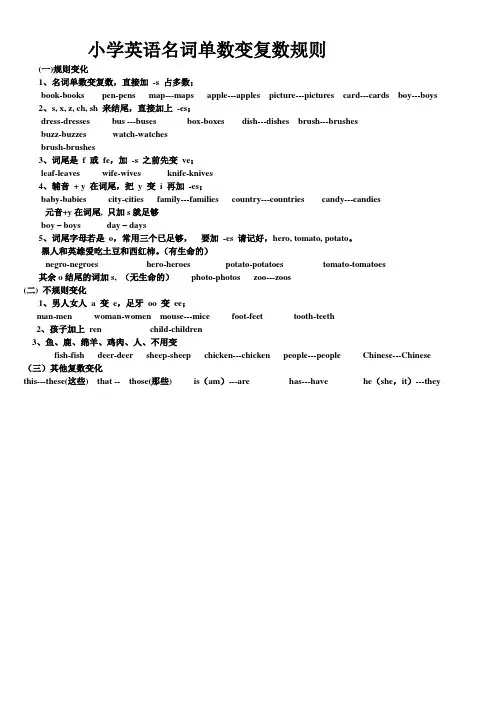
小学英语名词单数变复数规则(一)规则变化1、名词单数变复数,直接加-s 占多数;book-books pen-pens map---maps apple---apples picture---pictures card---cards boy---boys2、s, x, z, ch, sh 来结尾,直接加上-es;dress-dresses bus ---buses box-boxes dish---dishes brush---brushesbuzz-buzzes watch-watchesbrush-brushes3、词尾是f 或fe,加-s 之前先变ve;leaf-leaves wife-wives knife-knives4、辅音+ y 在词尾,把y 变i 再加-es;baby-babies city-cities family---families country---countries candy---candies元音+y在词尾, 只加s就足够boy – boys day – days5、词尾字母若是o,常用三个已足够,要加-es 请记好,hero, tomato, potato。
黑人和英雄爱吃土豆和西红柿。
(有生命的)negro-negroes hero-heroes potato-potatoes tomato-tomatoes其余o结尾的词加s, (无生命的)photo-photos zoo---zoos(二) 不规则变化1、男人女人a 变e,足牙oo 变ee;man-men woman-women mouse---mice foot-feet tooth-teeth2、孩子加上ren child-children3、鱼、鹿、绵羊、鸡肉、人、不用变fish-fish deer-deer sheep-sheep chicken---chicken people---people Chinese---Chinese (三)其他复数变化this---these(这些) that -- those(那些) is(am)---are has---have he(she,it)---they。
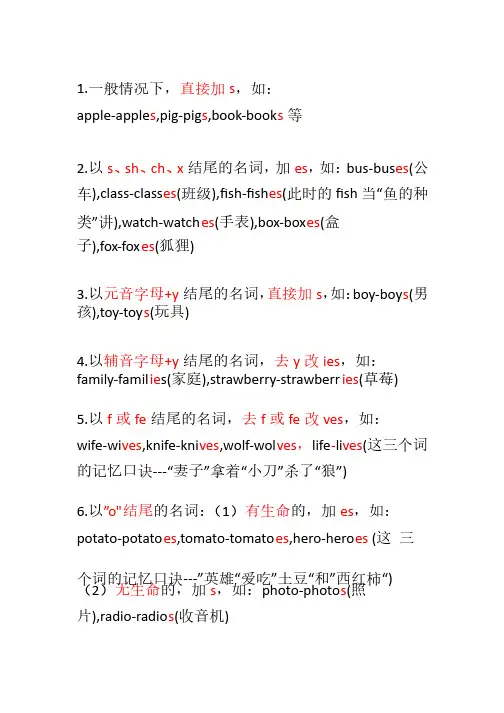
1.一般情况下,一般情况下,直接加直接加s ,如:apple-apple apple-apples s ,pig-pig ,pig-pigs s ,book-book ,book-books s 等2.以s 、sh 、ch 、x 结尾的名词,加es ,如:bus-bus bus-buses es (公车),class-class ),class-classeses (班级),fish-fish ),fish-fishes es (此时的fish 当“鱼的种类”讲),watch-watch ),watch-watcheses (手表),box-box ),box-boxes es (盒子),fox-fox ),fox-foxeses (狐狸)3.以元音字母+y 结尾的名词,直接加s ,如:boy-boy boy-boys s (男孩),toy-toy ),toy-toyss (玩具)4.以辅音字母+y 结尾的名词,结尾的名词,去去y 改ies ,如:family-famil family-familie ie s(家庭),strawberry-strawberr ),strawberry-strawberries ies (草莓)5.以f 或fe 结尾的名词,结尾的名词,去去f 或fe 改ves ,如:wife-wi wife-wives ves ,knife-kni ,knife-knives ves ,wolf-wol ,wolf-wolves ves ,life life--li lives ves (这三个词的记忆口诀------““妻子”拿着“小刀”杀了“狼”)6.以”o"结尾的名词:(1)有生命的,加es ,如:potato-potato potato-potatoes es ,tomato-tomato ,tomato-tomatoes es ,hero-hero ,hero-heroes es (这 三个词的记忆口诀------””英雄“爱吃”土豆“和”西红柿“)(2)无生命的,加s ,如:photo-photo photo-photoss (照片),radio-radio ),radio-radioss (收音机)7.将“oo”改为“ee"的名词,如:tooth-t tooth-tee ee th(牙),foot-f ),foot-fee ee t(脚),goose-g ),goose-gee ee se(鹅)8.单复同形的名词:(1)fish -fish(此时fish 当“同类鱼的很多条”讲),),sheepsheep -sheep(绵羊),),paperpaper -paper(纸),),Chinese Chinese -Chinese(中国人),),JapaneseJapanese -Japanese(日本人),),people people -people(peoples 表示“民族”)(2)不可数名词,如:water(水),rice(米饭),milk(牛奶),juice(果汁),bread(面包),tea(茶),orange(橙汁)9.不规则变化的名词:(1)man-men,woman-women (记忆方法------““男人”“女人”将a 改e) 延伸:policeman-policemen,policewoman-policemen (2)child-child child-children ren (孩子) (3)mouse-mice(老鼠) (4)根据中文意思变化的名词,如:I-we(我-我们),you-you(你-你们),he/she/it-they(他/她/它-他们),this-these(这个-这些),that-those(那个-那些)同学们,快来看看自己做的怎么样吧!小学英语可数名词单数变复数规律总结写出下列名词的复数形式:I this that watch child photo diary(日记) day(天)foot book dress(连衣裙) tooth sheep box strawbe rrywolf peach yo-yo(悠悠球) sandwich man womanpaper water juice tea mouse There are 56 (people)in China.答案:we these those watch watches es child children ren photo photos s diar diaries ies day days s f ee tbook books s dress dresses es t ee th sheep sheep box boxes es strawberr strawberries ies wol wolves ves peach peaches es yo-yo yo-yos s (悠悠球是“无生命”的,另外含有-符号的词是一个词,因此在结尾加s) sandwich sandwicheses m e n wom wome e npaper water juice tea mice people peoples s (这句话的意思是------““中国有56个民族”)。
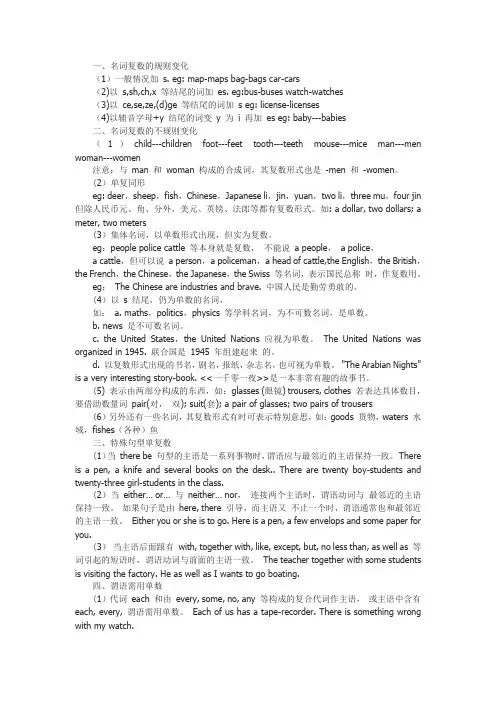
一、名词复数的规则变化(1)一般情况加s. eg: map-maps bag-bags car-cars(2)以s,sh,ch,x 等结尾的词加es. eg:bus-buses watch-watches(3)以ce,se,ze,(d)ge 等结尾的词加s eg: license-licenses(4)以辅音字母+y 结尾的词变y 为i 再加es eg: baby---babies二、名词复数的不规则变化(1)child---children foot---feet tooth---teeth mouse---mice man---men woman---women注意:与man 和woman 构成的合成词,其复数形式也是-men 和-women。
(2)单复同形eg: deer,sheep,fish,Chinese,Japanese li,jin,yuan,two li,three mu,four jin 但除人民币元、角、分外,美元、英镑、法郎等都有复数形式。
如: a dollar, two dollars; a meter, two meters(3)集体名词,以单数形式出现,但实为复数。
eg:people police cattle 等本身就是复数,不能说a people,a police,a cattle,但可以说a person,a policeman,a head of cattle,the English,the British,the French,the Chinese,the Japanese,the Swiss 等名词,表示国民总称时,作复数用。
eg:The Chinese are industries and brave. 中国人民是勤劳勇敢的。
(4)以s 结尾,仍为单数的名词,如: a. maths,politics,physics 等学科名词,为不可数名词,是单数。
b. news 是不可数名词。
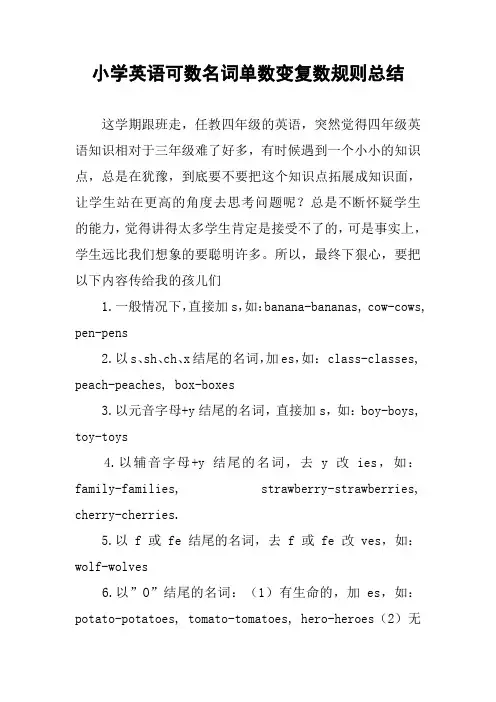
小学英语可数名词单数变复数规则总结这学期跟班走,任教四年级的英语,突然觉得四年级英语知识相对于三年级难了好多,有时候遇到一个小小的知识点,总是在犹豫,到底要不要把这个知识点拓展成知识面,让学生站在更高的角度去思考问题呢?总是不断怀疑学生的能力,觉得讲得太多学生肯定是接受不了的,可是事实上,学生远比我们想象的要聪明许多。
所以,最终下狠心,要把以下内容传给我的孩儿们1.一般情况下,直接加s,如:banana-bananas, cow-cows, pen-pens2.以s、sh、ch、x结尾的名词,加es,如: class-classes, peach-peaches, box-boxes3.以元音字母+y结尾的名词,直接加s,如:boy-boys, toy-toys4.以辅音字母+y结尾的名词,去y改ies,如:family-families, strawberry-strawberries, cherry-cherries.5.以f或fe结尾的名词,去f或fe改ves,如:wolf-wolves6.以”O”结尾的名词:(1)有生命的,加es,如:potato-potatoes, tomato-tomatoes, hero-heroes(2)无生命的,加s,如:photo-photos, radio-radios7.将”oo”改为“ee"的名词,如:tooth-teeth, foot-feet, goose-geese8.单复同形的名词:fish-fish, sheep-sheep, paper-paper, Chinese-Chinese, Japanese-Japanese9.不规则变化的名词: man-men, woman-women policeman-policemen, policewoman-policemen, child-children, mouse-mice。
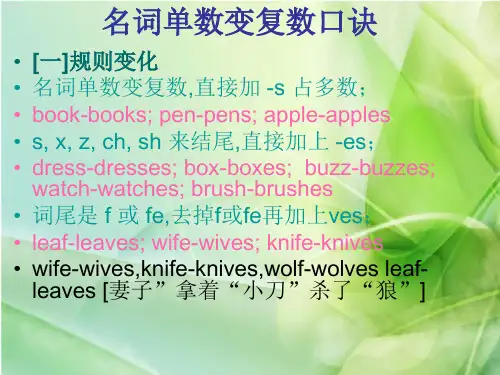
小学英语名词单复数变化规则及介词运用口诀名词单数变复数的规则变化1. 一般在名词词尾加"-s"map—maps地图bird—birds鸟orange—oranges 桔子bike—bikes自行车2. 以s, x, ch, sh结尾的名词加"-es"box—boxes盒子class—classes班级watch—watches手表dish-dishes盘,碟子,餐具3. 以o结尾的无生命的名词后面加"-s"photo—photos相片radio—radios收音机zoo—zoos动物园以o结尾的有生命的名词后面加"-es"tomato—tomatoes西红柿potato—potatoes土豆hero—heroes英雄negro—negroes黑人4. 以辅音字母加y结尾的名词,变y为i加"-es "baby—babies婴儿family—families家庭以元音字母加y结尾的名词直接加"-s"boy—boys男孩toy—toys 玩具5. 以fe或f结尾的名词,把fe或f变为v加"-es"knife—knives小刀wife—wives妻子leaf—leaves树叶名词单数变复数的不规则变化1. child—childrenfoot—feettooth—teethmouse—miceman—menwoman—women注意:与man 和woman构成的合成词,其复数形式也是-men 和-women,例如:an Englishman—two Englishmen但German不是合成词,故复数形式为Germans;Bowman是姓,其复数是the Bowmans(鲍曼一家)。
2. 单复数同形的名词例如:deer鹿,sheep绵羊,fish鱼,Chinese中国人,Japanese日本人注意:除人民币元、角、分外,美元、英镑、法郎等都有复数形式。
可数名词单复数变化规则口诀以下是为您生成的十个关于可数名词单复数变化规则的口诀:1. 一尾加 s 很平常,名词单数变复数。
比如 book 变 books,书桌desk 变 desks。
苹果 apple 加 s,香蕉 banana 也一样。
一个变多个就这样,简单又好记不用慌。
2. 二尾若为 ch、sh、x、s,后面加上 es 别遗忘。
比如 box 变 boxes,刷子 brush 变 brushes。
公共汽车 bus 变 buses,手表 watch 变 watches。
记住规则心不慌。
3. 一辅加 y 要留意,y 变 i 再加 es 记心底。
比如 baby 变 babies,糖果 candy 变 candies。
城市 city 变 cities,工厂 factory 变 factories。
轻松变化没问题。
4. 二辅加 y 很特别,直接加 s 不用变。
比如 boy 变 boys,玩具 toy变 toys。
一天一天多积累,复数变化都学会。
5. 一尾 f 或 fe,变成 ves 要认得。
比如 knife 变 knives,妻子 wife变 wives。
树叶 leaf 变 leaves,一半 half 变 halves。
仔细区分不会错。
6. 二尾 o 来真有趣,有生命加 es 没生命加 s。
比如 hero 变 heroes,土豆 potato 变 potatoes。
无生命就像 photo 加 s,钢琴 piano 也一样。
记住区分不迷茫。
7. 一尾 man 变 men,woman 同理要记真。
比如 man 变 men,女人woman 变 women。
英国男人 Englishman 变 Englishmen,复数变化要区分。
8. 二尾 foot 变 feet,牙齿 tooth 也同例。
比如 foot 变 feet,goose 变geese 要留意。
认真学习多练习,单复变化没问题。
9. 一尾 child 变 children,不规则变化要用心。
4.1可数名词一般来说个体名词和集体名词可以用数目来计算,称为可数名词。
可数名词有单数和复数两种形式。
例如: a book, two books, a student, three students, a family, many families。
名词单数变复数变化如下:◆词尾直接加s如:cat——cats bag——bags day——days◆以s, sh, ch, x 结尾的词加es如:class——classes, match——matches ,box----- boxes, dish ---- dishes, bus --- buses, peach --- peaches .◆以辅音加y结尾的词变y为i加es. 元音加y 结尾的词直接加s,如: party----parties city----cities story----stories family---families baby --- babiesboy---- toys monkey----- monkeys key---- keys等.◆以f或fe结尾的词, 变f或fe 为v, 加es,如: wife ---- wives, half---- halves, shelf—shelves, knife --- knives, life---lives,leaf---leaves.注意特殊情况直接加“s”,要逐个记chiefs, handkerchiefs , roofs.◆以辅音加o 结尾的词:有生命的加es如: tomatoes, potatoes, heroes.无生命的如s,如::radios, zoos, pianos, photos◆名词单数变复数特殊变化也要逐个记得如: man-men, woman-women, policeman-policemen, tooth---teeth, foot---feet, child--children,mouse-mice,goose---geese.(注意:以下单复同形:deer, sheep, species, means, Chinese, Japanese)练一练:一、请写出下列词的复数形式。
小学英语动名词相第三人称单数动词ing等变化总结小学英语动名词相第三人称单数动词ing等变化总结一、名词复数的变化规律1、规则变化1) 一般情况直接在词尾加-s . 如:chair—chairs;apple—apples;grape—grapes;desk—desks等。
2)以s、sh、ch、x等结尾的词加–es .如:bus—buses;watch—watches;box—boxes;brush—brushes等。
3)以辅音字母+y结尾的词,变y 为i 再加es,baby—babies;city—cities;family—families等。
4)以f或fe结尾的将f或fe直接换成ves. 如:knife—knives;thief—thieves;shelf—shelves等。
2、不规则变化1)没有规律的变化。
如:child—children;foot—feet;tooth—teeth;mouse—mice;woman—women等。
2)单复同形。
如:deer—deer;sheep—sheep;fish—fish;yuan—yuan;tofu—tofu;pork—pork等。
3)以o结尾的名词有的加es有的加s. 如:potato—potatoes;tomato—tomatoes;Hero—heroes等。
二、动词第三人称单数的变化规则1)直接在动词后+s. 如:like—likes;play—plays;read—reads;get—gets;help—helps;ski—skis等。
2)以s, x, sh, ch, 接尾的动词:+es. 如:wash—washes;wacth—watches;teach—teaches;brush—brushes等。
3)以辅音+o接尾的动词:+es. 如:go—goes;do—does等。
4)以辅音+y接尾的动词:变y为i+es. 如:fly—flies;study —studies;carry—carries;sky—skies等。
一、绝大多数的可数名词的复数形式,是在该词末尾加上后辍-s。
读音变化:结尾是清辅音读[s],结尾是浊辅音或元音读[z]。
例:friend→friends; cat→cats; style→styles; sport→sports; piece→pieces二、凡是以s、z、x、ch、sh结尾的词,在该词末尾加上后辍-es构成复数。
读音变化:统一加读[iz]。
例:bus→buses; quiz→quizzes; fox→foxes; match→matches; flash→flashes三、以辅音字母+y结尾的名词,将y改变为i,再加-es。
读音变化:加读[z]。
例:candy→candies; daisy→daisies; fairy→fairies; lady→ladies; story→stories四、以-o结尾的名词,如果不是外来词或缩写,就加-es,否则加-s构成复数。
读音变化:加读[z]。
例:tomato→tomatoes; potato→potatoes; torpedo→torpedoes; bingo→bingoes 反例:silo→silos; piano→pianos(外来词); photo→photos; macro→macros(缩写词)五、以-f或-fe结尾的名词,多为将-f或-fe改变为-ves,但有例外。
读音变化:尾音[f]改读[vz]。
例:knife→knives; life→lives; leaf→leaves; staff→staves; scarf→scarves反例:roof→roofs六、以-us结尾的名词(多为外来词),通常将-us改变为-i构成复数。
读音变化:尾音[Es]改读[ai],其中[kEs]要改读为[sai],[gEs]要改读为[dVai]。
例:fungus→fungi; abacus→abaci; focus→foci; cactus→cacti; cestus→cesti七、以-is结尾的名词,通常将-is改变为-es。
英语名词单数变复数归纳
一、规则名词的复数形式:
名词的复数形式,一般在单数形式后面加-s或-es。
具体如下:
1 、一般情况在词尾加-s:
如;map-maps, sea-seas, girl-girls, day-days
2 、以s, x, ch, sh结尾的名词后加-es:
如:class-classes, box-boxes, watch-watches(手表), dish-dishes(盘子), bus-buses
3 、以-f或-fe结尾的词,变-f和-fe为v再加-es:
如:leaf-leaves, thief-thieves(小偷,强盗), knife-knives, wolf-wolves(狼), wife-wives,
self-selves(自己), shelf-shelves(书架,架子),half-halves(一半) life-lives(生命);
歌谣:树叶半数自已黄妻拿刀割粮架窜狼像强盗逃命忙。
加-s:belief-beliefs(信仰), chief-chiefs(首领), proof-proofs(证据), roof-roofs(房顶), gulf-gulfs(海湾), handkerchief-handkerchieves(手帕)
歌谣:海湾边、屋顶首领奴仆两相望;谁说信仰证据写手帕
4 、以辅音字母加y结尾的名词,变y为i加-es :
如:party-parties, family-families, story-stories, city-cities
5 、以元音字母加y结尾的名词,或专有名词以y结尾的,加-s
如:toy-toys, boy-boys, day-days, ray-rays, Henry-Henrys
6、以辅音字母加-o结尾的名词一般加-es:
如:hero-heroes, Negro-Negroes, potato-potatoes, tomato-tomatoes;
黑人英雄爱吃土豆和西红柿。
不少外来词加-s:piano-pianos, photo-photos, auto-autos, kilo-kilos, solo-solos
两者皆可:zero-zeros/zeroes, volcano-volcanoes/ volcanos
7 、以元音字母加-o结尾的名词加-s:radio-radios, bamboo-bamboos, zoo-zoos
二、不规则名词复数:
1、改变名词中的元音字母或其他形式:
man-men, woman-women, foot-feet, goose-geese, mouse-mice child-children
2、单复数相同:sheep, deer, series, means, works, fish, species li, yuan, jin,
3、表示“某国人”加-s:Americans, Australians, Germans, Greeks, Swedes, Europeans;单复数同形Swiss, Chinese, Japanese;
以-man或-woman结尾的改为men,-women,Englishmen, Frenchwomen。